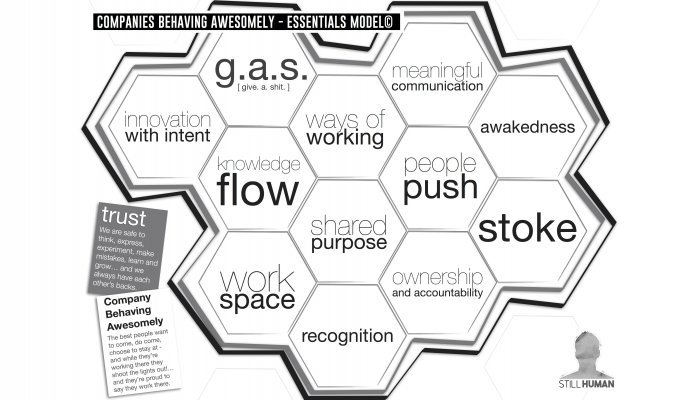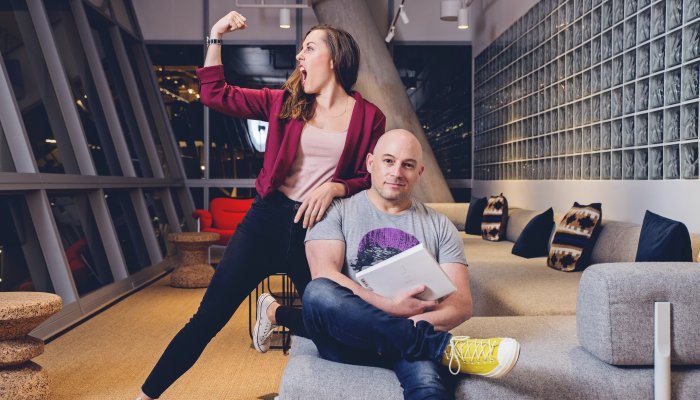Andy Golding and I explored this reality in our book We are Still Human [and work shouldn’t suck] in which we unpacked how awesome organisations to work for design, lead and sustain exceptional work experiences for human beings in a world that has gone digital crazy.
Undoubtedly, one of the failed ‘theories’ of today’s economy is that human beings are expendable. This doesn’t work. We need to understand that people matter. For any company to be innovative and innovation-fit we need to be attracting the best people to our organisations, and then embrace the diverse thinking that lives in the human capital fabric of our companies.
Leaders often forget about people being people. People desire, create and respond to human experiences. People are the heart of any business. The complexity is now how to connect with and access our people in this ever more digital environment. Companies and leaders who get this right will flourish. They understand that digital isn’t something that you do, it’s something you become, while still making people matter.
Technology is making the business world smaller and more efficient and is giving consumers more choice. In order to remain relevant, businesses have to be very aware of, and very adaptable to, what is going on in the broader environment. This is where people come in, because people – not machines – are the visionaries and the disruptors. People notice, people respond, people innovate. So, as a business owner or leader, you want the best people to join your organisation, and when they do you want to give them a consistently great employee experience, thereby better ensuring that they stay, and that they enthusiastically deliver excellence.
Switched on and grown
The underlying principle is to design a work environment that achieves that your employees are, what we call, ‘switched-on’. Research has shown a direct link between employees being switched-on – motivated, inspired, feeling connected and wanting to contribute – and their ability to deliver on business outputs and feel safe to innovate.
When leaders commit to switching employees on, they need to approach this with absolute intentionality. You cannot give lip service to switching people on. Every time you flick the ‘off’ switch you deplete the very people you are trying to inspire, and end up significantly diluting the process.
A ‘switched-off’ employee is one who feels disconnected, uninspired and demotivated. They do not feel as if they are being invited to contribute intellectually, and as a result they have no desire to participate. Imagine running a business with hundreds or thousands of switched-off employees. Now think of the value that this same number of switched-on employees would have on the growth potential of your organisation.
We cannot escape the fact that even in a digital world, human beings are critical to shaping the future of business. There are certain human skills and behaviours that cannot be duplicated by machines. Curiosity, imagination and creativity are still very human attributes. Machines cannot yet ‘people’ better than people, and people cannot ‘machine’ better than machines.
Sure, machines deliver, but humans over-deliver. Machines automate, but humans innovate. Machines apply reason, while humans apply reason and emotion. It is these subtle nuances that can make the world of difference to the degree of relevance which consumers assign to a brand and brand experience.
Still not convinced? Consider this... Increasingly, research is showing that more people die today from workplace stress-related illnesses than they do from smoking or excessive sugar consumption. Evidence further suggests that absenteeism, stress and mental health issues are directly linked to negative work environments. In May 2019, the World Health Organization classified burnout as an ‘occupational phenomenon’.
Leaders are increasingly becoming obliged to start questioning just how seriously they are taking the issue of health and well-being in the workplace. Are they taking the necessary steps to ensure that the workplace fosters positive and healthy experiences for its people, or possibly unknowingly contributing to chronic employee illness and possibly even death?
Bees like honey
In order to build a workplace that delivers a great employee experience, leaders need to strive to create what we call a Company Behaving Awesomely (or a CBA). We coined this phrase during our research and expand upon it in our book. Great talent wants to join a CBA and, most importantly, once employed they choose to stay and strive to deliver exceptionally.
The only reason someone should ever choose to leave a CBA is because a better opportunity has arisen elsewhere that your organisation just cannot compete with. But, should a matching opportunity present itself in your business at a later stage, they would be clamouring to return.
When you peel away the layers, Companies Behaving Awesomely all share certain key components of the employee experience that make them hugely attractive to the best candidates in the market. Our observation process identified 12 of these components which we appropriately called the 12 Essentials of a Company Behaving Awesomely. These 12 Essentials are:
- G.A.S. (give a sh*t)
- Ways of working
- Meaningful communication
- Awakedness
- People push
- Stoke (the wow factor)
- Ownership and accountability
- Shared purpose
- Knowledge flow
- Recognition
- Workspace
- Innovation with intent
These components are visually articulated in a honeycomb structure because each cell offers support and stability to the surrounding cells. If one fails the others will, more than likely, also start to collapse. They all impact each other, always. They all need to be delivered at the highest possible levels of human experience in order to create an awesome employee experience, and to create trust as a constant.
The evolution of the leadership role
Getting this honeycomb in perfect balance, and creating CBAs, is not an accidental process. To work effectively and optimally it must become a strategic priority, the people strategy. Leaders and managers need to understand that it is up to them to constantly create the right experience for the people around them. Choosing to go this route can be demanding as it requires some difficult decision-making, and often gets uncomfortable.
We worked with an organisation whose CEO had to make the tough call to eject one of their most senior C-suite executives in order to ensure a happier and healthier work environment. This particular executive was exposed through our employee experience assessment as being the strongest contributor to the negative experience that employees were having, and he refused to change his ways. The CEO made a bold move, but it was the correct decision. Even more notable was the fact that he and the errant exec were long-time colleagues and close friends.
The results of such actions can be extremely positive. Ask yourself: What would the impact be if you could deliver meaningful communication through which you increase ownership and accountability and, in the process, enhance the ways of working and thereby foster more innovation readiness? How much could you anticipate seeing a positive shift in your metrics, both human capital and business output? This is a simple demonstration of how the interconnectedness of just four of the 12 Essentials, when properly applied, has a significant impact where it matters most.
Because we understand the impact of bold actions, we urge leaders to spend their time thinking about their company values and building solid people strategies around these. This will inform how leaders ignite their employees, how they connect with them, and how they focus employees on the business and the bigger picture. In other words, a CEO should ensure that the people strategy is aligned with the company strategy and is underpinned by the articulated organisational values construct.
There is no trade-off in this approach. The natural default, fear-driven mindset is one that is concerned that other business objectives will potentially suffer as a result of this people focus. On the contrary, they will thrive. All it takes is flicking a switch in the minds of your leaders, your strategy, your business and your employees. Then let your people do what they do best: shine.
The starting points
- Know and understand the type of culture and employee experience that you want to create.
- Define what behaviour is acceptable and what won’t be tolerated in your organisation. You as a leader must walk your talk.
- Invite your employees to ask questions, voice opinions and feel safe to make mistakes. A fear-driven, command-and-control style of leadership switches people off.
- An awesome employee experience starts even before the first day a new employee joins your company. The candidate experience, interview process and onboarding must show that yours is a company behaving awesomely.
- As a CEO, walk the corridors, be available to your employees and hear what they have to say. Perceptions of the workplace experience often differ greatly between leaders and employees.
- Consider creating the critical role of Employee Experience Orchestrator as a specialist function, and recruit and upskill the right person for this very meaningful position.
KEY TAKEAWAYS
- Leaders should regard employee well-being as a strategic priority. Foster a work environment that switches people on.
- Switched on employees want to contribute and will give their own best discretionary effort towards business outputs and innovation opportunities.
- Negative employee experiences can impact employee health, increasing rates of absenteeism, stress and mental health issues, and undermine the business’ bottom line.
- Human beings need to be valued. Machines cannot replicate the creative skills and behaviours that people bring to their jobs.
- Companies Behaving Awesomely are companies that the best talent wants to come to, chooses to stay at, and while they’re there, excel.
- CEOs have two main roles in an organisation. One is to focus on strategy and meeting business objectives. The second, which is equally, if not even more important, is to obsess about how to create an awesome employee experience.
...people matter.
A ‘switched-off’ employee is one who feels disconnected, uninspired, and demotivated.
Getting this honeycomb in perfect balance, and creating CBAs, is not an accidental process.
Brad Shorkend, Adjunct Faculty at GIBS, is an agitator & thought provoker, and Co-founder/Co-CEO of Still Human [Relevance Advisory]… as a behavioural specialist he works with organizations and business leaders around the world helping them to be human relevant in a world gone digital crazy.
He obsesses with creating company cultures of constant innovation readiness where exceptional employee and customer experience translates into sustainable innovation, constant relevance, and significant revenue.








